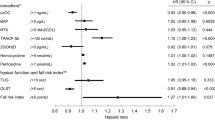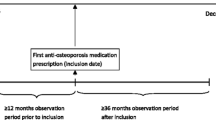Abstract
Placebo controls are essential to assess anti-fracture efficacy of new osteoporosis therapies, but inclusion of a placebo arm in a subsequent clinical trial may be limited by practical or ethical considerations; in these cases, use of an historical control may be appropriate. A recent active-controlled study of risedronate 35 mg once a week demonstrated that this regimen produces increases in bone mineral density (BMD) that are comparable to those seen with the risedronate 5 mg daily dose, which has proven anti-fracture efficacy. To assess the anti-fracture efficacy of this new regimen, we have analyzed the fracture data collected in an active controlled study of risedronate dosing regimens (the Once-a-Week study) using matched historical control data from previous placebo-controlled trials. Women in the Once-a-Week study were matched for age, years since menopause, BMD, and prevalent vertebral fracture status, with placebo patients in the Vertebral Efficacy of Risedronate Therapy (VERT) trials forming an historical placebo group. We also constructed an historical active treatment group from the 5 mg daily arm of the VERT trials for comparison with the 5 mg daily and 35 mg once weekly treatment groups in the Once-a-Week study. Data were obtained from the risedronate 5 mg daily group (n=480) and 35 mg once-a-week group (n=485) in the Once-a-Week study and historical control groups representing daily placebo patients (n=114, matched from 993) and risedronate 5 mg daily patients (n=120; matched from 990) in the VERT studies. Patients received calcium supplementation (1000 mg daily); vitamin D was given if baseline serum 25-hydroxyvitamin D levels were low. Over 1 year, new vertebral fracture risk in the 35 mg once-a-week group was reduced by 77% relative to the historical placebo group (1.2% versus 5.0%; RR 0.23; 95% CI, 0.54 to 0.91, P=0.018), similar to the 1-year risk reduction observed in the VERT trials of risedronate 5 mg daily (61–65%). The incidence of new vertebral fractures in the three active treatment groups was similar: 1.7% in the historical risedronate 5 mg group, 1.5% in the risedronate 5 mg daily group from the Once-a-Week study, and 1.2% in the 35 mg once-a-week group. Risedronate 35 mg once a week appears as effective as the 5 mg daily dose in reducing the risk of new vertebral fractures in the first year of treatment. The use of appropriate historical control data provides an approach to the assessment of fracture effects in osteoporosis trials for which placebo-controlled data are not available.


Similar content being viewed by others
References
Harris ST, Watts NB, Genant HK et al. (1999) Effects of risedronate treatment on vertebral and nonvertebral fractures in women with postmenopausal osteoporosis. A randomized controlled trial. JAMA 282:1344–1352
Reginster J, Minne HW, Sorensen OH et al. (2000) Randomized trial of the effects of risedronate on vertebral fractures in women with established postmenopausal osteoporosis. Osteoporos Int 11:83–91
Cohen S, Levy RM, Keller M et al. (1999) Risedronate therapy prevents corticosteroid-induced bone loss. Arthr Rheum 42:2309–2318
Reid DM, Hughes RA, Laan R et al. (2000) Efficacy and safety of daily risedronate in the treatment of corticosteroid-induced osteoporosis in men and women: a randomized trial. J Bone Miner Res 15:1006–1013
Wallach S, Cohen S, Reid DM et al. (2000) Effects of risedronate treatment on bone density and vertebral fracture in patients on corticosteroid therapy. Calcif Tissue Int 67:277–285
Brown J, Kendler D, McClung MR et al. (2002) The efficacy and tolerability of risedronate once a week for the treatment of osteoporosis. Calcif Tissue Int 71:103–111
Cleophas TJ, Zwinderman AH (2000) Limitations of randomized clinical trials. Proposed alternative designs. Clin Chem Lab Med 38:1217–1223
Rosner F (1987) The ethics of randomized clinical trials. Am J Med 82:283–290
Cummings SR, Black DM, Thompson ED et al. (1998) Effect of alendronate on risk of fracture in women with low bone density but without vertebral fractures. Results from the Fracture Intervention Trial. JAMA 280:2077–2082
Ettinger B, Black DM, Mitlak BH et al. (1999) Reduction in vertebral fracture risk in postmenopausal women with osteoporosis treated with raloxifene. Results from a 3-year randomized clinical trial. JAMA 282:637–645
Black DM, Cummings SR, Karpf DB et al. (1996) Randomised trial of effect of alendronate on risk of fracture in women with existing vertebral fractures. Lancet 348:1535–1541
Chesnut CH, III, Silverman S, Andriano K et al. (2000) A randomized trial of nasal spray salmon calcitonin in postmenopausal women with established osteoporosis: the Prevent Recurrence of Osteoporotic Fractures Study. Am J Med 109:267–276
Gehan EA (1984) The evaluation of therapies: historical control studies. Stat Med 3:315–324
Pocock SJ (1976) The combination of randomized and historical controls in clinical trials. J Chron Dis 29:175–188
Acknowledgements
These studies were supported by grants from Procter & Gamble Pharmaceuticals, Inc., Cincinnati, Ohio, and Aventis Pharma, Bridgewater, New Jersey. The authors acknowledge Michael Meredith and Lisa Bosch for assistance in the preparation of the manuscript.
Author information
Authors and Affiliations
Corresponding author
Additional information
Employees of Procter & Gamble Pharmaceuticals, Inc., Cincinnati, Ohio, and Aventis Pharma, Bridgewater, New Jersey, participated in the designs of these studies, the analysis of the data, and in the preparation of the manuscript. The authors had full access to the data and analyses. N.B.W., as lead author, made the decision concerning where to submit the paper, and takes responsibility for the integrity of the data and the accuracy of the analysis.
Rights and permissions
About this article
Cite this article
Watts, N.B., Lindsay, R., Li, Z. et al. Use of matched historical controls to evaluate the anti-fracture efficacy of once-a-week risedronate. Osteoporos Int 14, 437–441 (2003). https://doi.org/10.1007/s00198-003-1401-8
Received:
Accepted:
Published:
Issue Date:
DOI: https://doi.org/10.1007/s00198-003-1401-8




